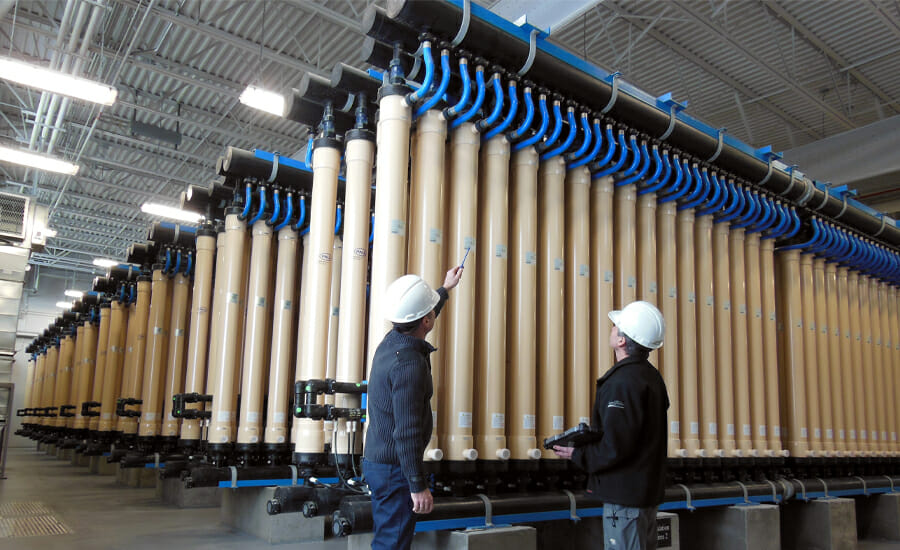When the City of Sherbrooke turned to us to upgrade the J.M.-Jeanson drinking water production plant, little did we know that this project would mark a turning point in the way we, and the next generation of engineers would design systems and plants that ensure the quality of the water we drink every day.
The order was tall and complex: designing a drinking water production plant capable of serving a growing population, equipping it with a much more sophisticated and complex treatment chain, ensuring environmental sustainability, safeguarding operators and neighboring residents, reducing operating costs, and the list goes on! And it all had to happen in a tight space without interrupting drinking water production for the city’s 160,000 residents. It was an exciting and rewarding project for us and the small team of EXP employees whose skills and commitment we knew would lead us to success.
Of course, this multifaceted project would not be simple. Sourced from Lake Memphremagog, the water that needs to be treated appears quite clear to the naked eye. Because the raw water was so lightly loaded, a conventional treatment system, with settlers and regular filters, was not an option. In-situ pilot testing conducted by our team using direct filtration and pressure-driven ultrafiltration showed that, even with coagulation, such processes were, at best, only adequate. We had to find a better solution, and that’s exactly what Julie did.
For me, designing systems that provide people with quality drinking water is a way of contributing to enhancing people’s quality of life. In this case, our client, the City of Sherbrooke, also shared the same desire to go above the standard requirements and expectations. The collaboration that was quickly established with the City allowed us to bring the project to another level. Their needs were well defined, their expectations were clear and they stemmed from hands-on experience of the existing plant’s operation.
Designing the water treatment system was one key element of this complex project but designing a facility that could house the treatment system was an entirely different piece we had to conquer. Fortunately, challenging plant design was right up Jean-Yves’s alley.
While Julie is the water treatment expert and was busy designing the filtration system, I took on the challenges associated with designing the plant. We needed the building to be able to house a treatment chain that would be much larger than the existing treatment system—as filtration was now required under the new regulation—but also compact enough for the limited space we had to work with. Each of us had to deal with design criteria that were essentially dictated by the other’s design work. Combining all elements to achieve a perfect fit forced us both to change the way we usually work and fuse our skills and experience. We discussed the project every week and all the decisions we made, we made together.
With today’s increased focus on sustainable development and community participation, social acceptability of the project was also at the core of our scientific approach.
We wanted the upgraded plant to reflect the City’s commitment to its residents on matters such as safety, environmental protection and financial viability. And we did it.
For example, by replacing chlorine gas — highly toxic and volatile — with its liquid form, we made the plant safer for its operators and for the thousands of people who live, study and work right across the street at the Sherbrooke University campus. We chose equipment and designed a process that keeps energy consumption, use of chemicals and discharge to sewer to a minimum. By making sure we used the best and most up-to-date technology — even when it meant changing part of the plan because a previously unaffordable technology had suddenly become affordable — we were able to transform the existing installation to house what was, at the time, Quebec’s largest drinking water membrane filtration system and the world’s largest very-high-frequency ozonation system, increasing the plant’s footprint by no more than 1,165 m2. And, by creating a treatment process that doesn’t require chemicals other than chlorine to be added to the treatment chain, we were able to preserve several of the source water’s unique properties, including those that make it taste so good.
We accomplished these milestones within deadlines and 10% under budget, which, of course, also pleased our client.
This plant is one of the projects we’re most proud of, and not just because it’s a state-of-the-art facility equipped with a highly innovative treatment process. We’re proud because it has already inspired similar projects that will, in turn, inspire others. And that’s what engineering is all about: working together to drive progress and build a better, safer, and healthier tomorrow.
Working so closely with another person was also a very rewarding experience. It changed our perspective, it transformed the way we communicate, and in the end, it’s what allowed us to deliver a project that exceeded expectations, including our own. And, as a bonus, we get to be the two to go up on the stage to receive the awards!
Julie Cormier, P.Eng., M.A.SC., | Co-Project Manager | Montreal, QC
Jean-Yves Lavoie, P.Eng. | Director Of Urban Infrastructures and Co-Project Manager | Sherbrooke, QC
*Originally published in EXP’s Expresso: Convergence

